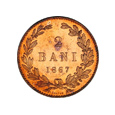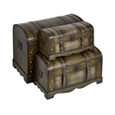HAND CROSSES FROM THE 17TH AND 18TH CENTURY
Text: Raluca Mălăncioiu / photo: Marius Amarie.
The cross – a synthesis of Christianity
Before Christianity, the geometrical shape of the cross was used for symbolically representing universal harmony, the two crossed arms indicating the directions of the four cardinal points, whereas their intersection stood for the center of the universe. Besides the previous symbolism of the graphic sign, the term with a Christian connotation that we use in Romanian has as its etymon the Latin word crux, which referred to a wooden pole, used as an instrument of torture for those sentenced to death, accused of rebellion, or for slaves. The Roman law considered crucifixion the most severe public torture, meant to intimidate and discourage any opponent. Whether they used crux commisa – the Tau(T)-shaped cross, crux immissa, the one we illustrate in Christian iconography, crux decussata, the one in the shape of a Greek X, more rarely used and currently known as St. Andrew’s cross, the cross was the most feared ordeal that the ancient world could imagine. So far, these three forms of cross have enjoyed the largest expansion, although, typologically speaking, there are over 400 shapes of cross.
Symbolically, the cross is the very essence of Christian faith. The early Christian communities shared the conviction that the instrument on which Man-God was sacrificed brought the victory over death, implicitly resurrection and life. The faith in the Cross and in Resurrection has been the message of the Christian missionaries since the first centuries. The promise In hoc signo vinces (“In this sign you will win”), uttered together with the revelation of the cross in the sky during wartime, as, according to tradition, it was revealed to the Roman emperor Constantine the Great (306 – 337) became a convincing argument for the official conversion to Christianity. Through the Edict of Mediolanum (Milan), in 313, Constantine declared Christianity a legal religion, thus stopping the persecutions and clandestineness that affected the believers of Christ’s first church. The cross sign was adopted as an imperial symbol, displayed on the flags and on the coins. Before Constantine the Great, the cross had been worshipped only during secret religious rituals or as a sign of belonging to the Christian community. In the Eastern Christian iconography, emperor Constantine is depicted together with his mother, Helen, on either side of the cross, this representation being in accordance with the church traditions regarding the part played by Helen in the acceptance and spread of the Christian faith. Her participation and role in discovering the relic of the wood from the Holy Cross are mentioned by the oral tradition, as well as by 4th-century written religious sources, which tell about the pilgrimage made by the emperor’s mother on the Golgotha in Jerusalem and about the discovery of the Holy Sepulcher. There are references to Helen’s voyage in the Catechetical Lectures by St. Cyril of Jerusalem (315 – 385), in the writings by St. Gregory of Nyssa, St. John Chrysostom, in Historia ecclesiastica by Gelasius, the Metropolitan Bishop of Caesarea (Palestine), in the Ecclesiastic History written by the historian Socrates the Scholar (380 – 450), etc. The history of early Christianity, as it is presented in the basic written sources, is completed by the tradition, the second greatest source of information, after the Holy Gospel.
The tradition and value of the cross in Christian life has been mentioned since the earliest times by two of the most important representatives of the old Christian Church: Tertullian (the 2nd – 3rd century) and St. Basil the Great (the 4th century). Speaking about the cross sign, Tertullian emphasizes the importance of tradition and true faith for Christianity. Likewise, St. Basil the Great is one of the defenders of the dogmas from the Apostles’ tradition, besides the written teaching, both claiming that the two forms of transmitting the message are equally important for faith.
During the 7th Ecumenical Synod in Nicaea in 787, it is established that the Holy Cross should be worshipped in the same way as the Holy Icons, as it has become the symbol of Christian life and the hope for eternal life. In Christianity nowadays, the cross is a symbol of sacrifice and triumph, of the redemption brought by Christ, which reminds the believers that God did not hesitate to sacrifice His only Son in order to prove His love for humans. The concept of cross has become the essence of Christianity, revealing Jesus’s victory over sins and death, since, through His Resurrection, He managed to defeat death – the inexistence. The cross sign is used by most Christian denominations: Orthodox, Roman-Catholic, Greek-Catholic, Eastern Orthodox, members of some major branches of Lutheranism, some Anglicans and many other Christians in the world.
Hand crosses
Hand crosses, used during the Orthodox divine service, are a very diverse category of religious objects with a significant patrimonial value. Made of various materials, from wood to precious metals, embellished with the most expensive gemstones, hand crosses, also known as blessing crosses, are kept on the table in the altar and displayed for worshipping, together with the Holy Books. They are worshipped similarly to icons, during the religious processions, especially during the consecration of holy water and for blessing the believers. As some of the personal items of
the Romanian voivodes, hand crosses were symbolizing the ruler’s testimony of faith, as well as his important role of founder and protector of Orthodoxy. The iconographical representations showing such items are significant for identifying the importance of the hand cross as a religious object. Besides the canonical compositions, in which, in most of the cases, the Church Fathers are depicted with hand crosses, just like the holy martyrs or major religious personalities, who were wearing this item during their life, this type of object is represented in the frescos of the
votive paintings depicting church founders, usually of noble origins.
The religious decorative art in the Romanian Principalities in the 17th century and the beginning of the 18th century reflects the traditional Slav-Byzantine character, as well as the intensification of the relationships with the silversmiths in Transylvania. In the composition of the scenes that decorate the works in the Romanian Principalities during this period, the Western influences can be recognized, inasmuch as in painting. The architectural ornamentation and scenography of Gothic influence, populated with finely rendered, detailed characters, with natural, expressive
gestures, a perfect balance of shapes and scene dynamics, a technique of decoration with colored enamels, the motifs of Renaissance influence point to an increase in the activity of the Transylvanian craftsmen and testify for the wealth of the commissioners – rulers of boyars from Wallachia and Moldavia.
INVENTORY NUMBER 131455
Material: gilded silver, wood, common metal.
Technique: carving, embedding, chiseling, fretting, riveting.
Sizes: Length = 28.5 cm; Width = 14.5 cm; Thickness = 2.5 cm
Dating: 1 September 1639 – 31 August 1640 (anno mundi 7148)
Workshop/ author: unknown
Hand cross for blessing, which belonged to the ruler of Wallachia, Matei Basarab (1632 – 1654).
INVENTORY NUMBER 131458
Material: silver, gold, non-expertized red and green gemstones, 6 pearls, wood, niello.
Technique: hammering, chiseling, carving, niello working, guilloche working
Sizes: Length = 28 cm; Width = 14 cm; Thickness = 3.5 cm
Dating: the second half of the 17th century, 1670-1671
Workshop/ author: Balkan workshop
Hand cross or blessing cross that belonged to the Wallachian ruler Antonie (1669 – 1672).
Technique: hammering, chiseling, enameling, crimping gemstones.
Dating: 1664
Sizes: Height = 17.6 cm; Width = 7.9 mm; Weight = 78.29 gr.
Title Au 583‰ (according to the analysis bulletin BNRSR 18040/1980)
Dating: 1664
INVENTORY NUMBER 131517
Material: gold, emeralds, diamonds, wood, enamel.
Technique: hitting, hammering, chiseling, niello working, crimping gemstones, polishing.
Sizes: Height = 17.8 cm; Width = 7.7 cm; Thickness = 6.6 mm; Weight = 114.77 gr.
Title Au 750‰ , 13 emeralds – approx.. 20 kt. and 8 diamonds – approx. 1 kt.) (according to the analysis bulletin
BNRSR 32309/1979)
Dating: 1694
Gold hand cross that belonged to the ruler Constantin Brâncoveanu (1688-1714).
INVENTORY NUMBER 131518
Material: gold, wood, rubies, diamonds, emeralds, enamel.
Technique: hitting, laminating, snipping, gluing, incising, inlaying, cutting, polishing the gemstones
Sizes: Length = 19.8 cm; Width = 7.2 cm; Thickness = 2 cm; Weight =189.28 g
Title Au 750‰ , 110 rubies of approximately 23 kt; 4 emeralds of approximately 15 kt.; 21 diamonds of approximately
7 kt.; 7 gemstones are missing (according to the analysis bulletin BNRSR 32308/1979)
Dating: the 17th – 18th century
INVENTORY NUMBER 131521
Material: gold, gilded silver, pearls, rubies, emeralds, diamonds, enamel.
Technique: casting, hammering, chiseling, enameling, crimping of gemstones.
Sizes: Height = 16.4 cm; Width: 7.1 cm; Weight = 78.44 gr
Title Au 750‰ (according to the analysis bulletin BNRSR 18040/1980)
Dating: 1706
Hand cross that belonged to the Metropolitan Bishop of Ungro-Wallachia, Teodosie.


















